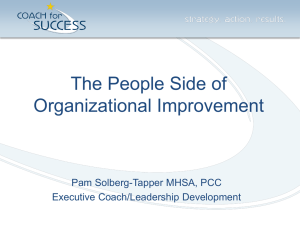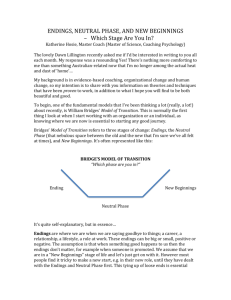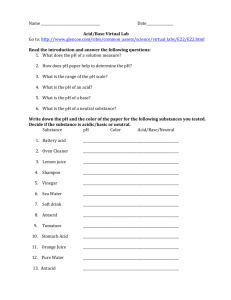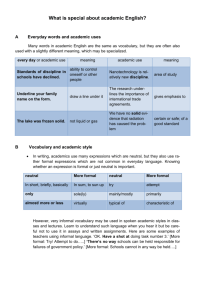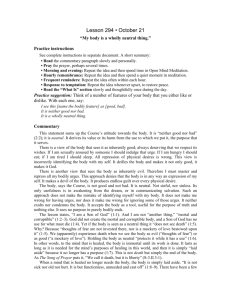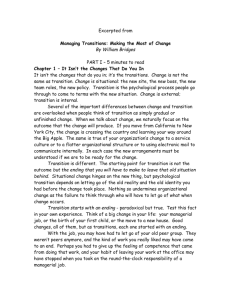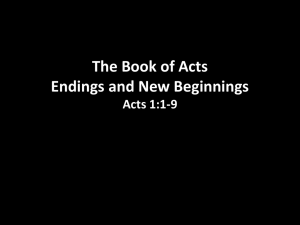Managing Transitions - The Dooley Group Leadership Counsel
advertisement
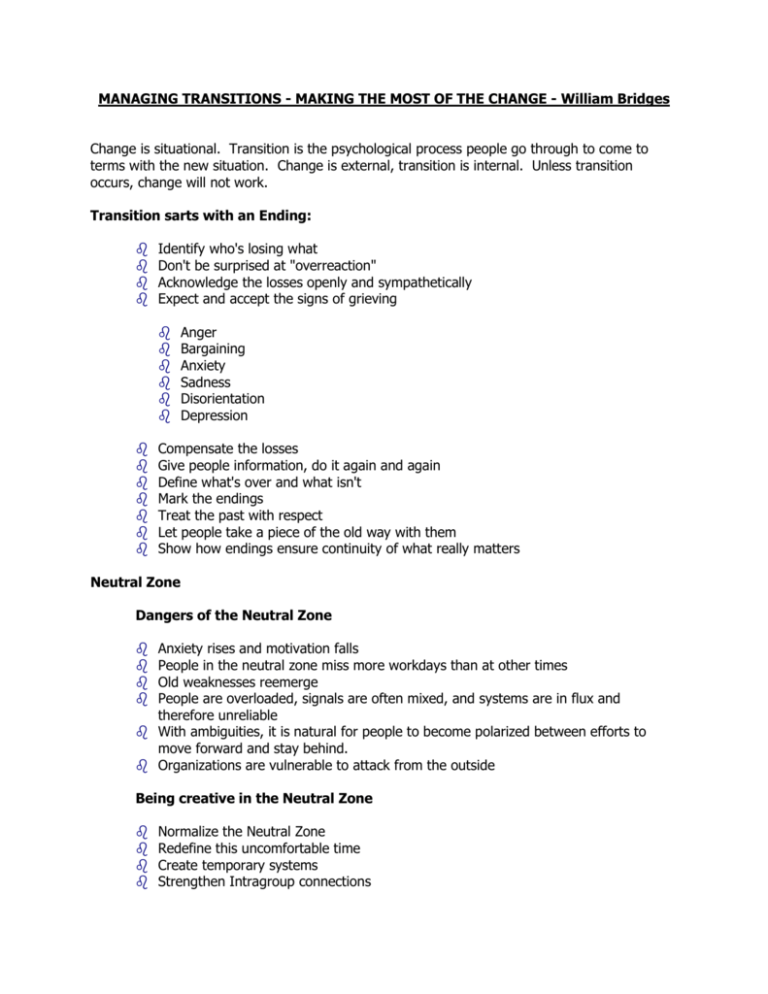
MANAGING TRANSITIONS - MAKING THE MOST OF THE CHANGE - William Bridges Change is situational. Transition is the psychological process people go through to come to terms with the new situation. Change is external, transition is internal. Unless transition occurs, change will not work. Transition sarts with an Ending: Identify who's losing what Don't be surprised at "overreaction" Acknowledge the losses openly and sympathetically Expect and accept the signs of grieving Anger Bargaining Anxiety Sadness Disorientation Depression Compensate the losses Give people information, do it again and again Define what's over and what isn't Mark the endings Treat the past with respect Let people take a piece of the old way with them Show how endings ensure continuity of what really matters Neutral Zone Dangers of the Neutral Zone Anxiety rises and motivation falls People in the neutral zone miss more workdays than at other times Old weaknesses reemerge People are overloaded, signals are often mixed, and systems are in flux and therefore unreliable With ambiguities, it is natural for people to become polarized between efforts to move forward and stay behind. Organizations are vulnerable to attack from the outside Being creative in the Neutral Zone Normalize the Neutral Zone Redefine this uncomfortable time Create temporary systems Strengthen Intragroup connections Use a transition monitoring team Use the Neutral Zone creatively Establish that this is the time to step back and take stock Provide opportunities for others to do the same Provide training in the techniques of discovery and innovation Encourage experiment Embrace losses, setbacks, or disadvantages as entry points for new solutions Look for opportunities to brainstorm new answers to old problems Restrain the impulse to push prematurely for certainty and closure. "Debrouillez-vous!" - Sort them out New Beginnings Beginnings feel frightening Beginnings can reactivate some of the old anxieties that were triggered by the ending The new ways represent a gamble The prospect of a risky new beginning resonates with the past For some, new beginnings destroy a pleasant neutral zone Using the Four P's 1. 2. 3. 4. Purpose - explain the purpose behind the outcome you seek Picture - paint a picture of how the outcome will look and feel Plan - lay out a step-by-step plan for phasing the outcome Part - give each person a part to play in both the plan and the outcome Rules of Reinforcing the New Beginnings 1. 2. 3. 4. Be consistent Ensure quick successes Symbolize the new identity Celebrate the success Managing Nonstop Change Postpone "extra" changes Foresee as much as you can Do worst-case scenarios Make the transition to "Change as the Norm" Clarify your mission Rebuild trust Unload old baggage Sell problems, not solutions Challenge and response Taking Care of Yourself Figure out what is actually changing Decided what is really over for you Distinguish between current losses and old wounds Identify your continuities Recognize the symptoms of the Neutral Zone Take Time-outs Use the Neutral Zone as an opportunity to take stock Look at yourself creatively Consider your possibilities in a new light Experiment a little every day Design a learning venture Make a plan to change your life Remember that changes put you into transition 1. Show up 2. Be present 3. Tell the truth "Transition is the process people go through to come to terms with a new situation." - Bridges, 1991 Change is external: something stops Transition is internal: a person's reaction Usually has an assigned date. It's different for everyone. and starts - a new situation - a new site, a new boss, a new organization, a new policy. to and handling of change. Transition is what people really are resisting, not the change itself. TRANSITION HAS THREE STAGES: ENDING NEUTRAL ZONE BEGINNIN G ENDINGS: NEUTRAL ZONE: BEGINNINGS: Letting go of something. No-man's land between the old reality and the new; time when the old way is gone and the new isn't comfortable yet. New understandings, new values, new attitudes, new identities, and new ways of doing things. Employee reaction, questions, and issues PEOPLE'S REACTIONS TO ENDINGS: Ending means letting go of something, and letting go implies loss. People grieve or react to loss differently. Emotion Reaction Denial - The natural first reaction, a buffer or temporary defense after unexpected news. Examples Reaction to news is "No, not me." Anger - Everything from grumbling to rage. Anger may be misdirected at the boss, family, or people not directly related to the change. Bargaining - An attempt to postpone the inevitable. "I'll double my output if you will undo the change." Sadness or Depression Sense of loss, feelings of hopelessness. People are immobilized, nonproductive. ENDINGS People ask "Why" questions: Why is this happening? Why now? Why me? Why us? NEUTRAL ZONE Anxiety increases. Motivation decreases. Missed days increase. People are confused and isolated. You may see people: Try to continue the old way. Toss everything out the window. Try to do the old and the new. (Hint: See above for ideas on Ambiguity causes some people to hang on to the past and some people to anticipate the future. Can be a creative time. What to Do This healthy reaction doesn't need your action if it doesn't last too long. Otherwise you must address the issue head on by continuing to give people straightforward information about the change. Acknowledge that anger is understandable. Listen. Distinguish between the acceptable feelings and unacceptable acting-out behavior. Separate beginning from real problem-solving. Don't be swayed by unrealistic arguments. Help people find ways to regain control; Empathize, realizing you can't take the feelings away. BEGINNINGS Beginnings are scary - a time to commit to be the new person the new situation demands. It is also difficult because in this stage people see that the "ending" was real, the "neutral zone" was becoming the norm, and the new way or "beginning" is a gamble. What you can do: handling emotional reactions.) IDENTIFY WHAT IS ACTUALLY GOING TO CHANGE AND WHO IS LOSING WHAT NORMALIZE THE NEUTRAL ZONE - Communicate the latest information on the change. Explain what the "Neutral zone" is, and that it ACCEPT THE IMPORTANCE OF is normal. Let people know LOSSES - Losses are their feelings are natural. subjective - Employees may Establish short-term goals to experience the loss of: keep people focused. Security, Territory, Competence, Relationships, CREATE TEMPORARY Sense of Direction. SYSTEMS - Reduce changes in other areas. Review normal ACKNOWLEDGE THE LOSSES operating policies for SIMPLY, OPENLY, DIRECTLY, relevancy during the AND SYMPATHETICALLY transition. Identify special training needs to help people YOU MAY SEE through the neutral zone. "VERREACTION" - EXPECT THE SIGNS OF GRIEVING STRENGTHEN INTRAGROUP people are reacting to their CONNECTIONS - Maintain a losses in their own way. sense of belonging to a group. Create formal and informal COMPENSATE FOR LOSSES opportunities for people to What can you give back to provide support to each other. offset what's been taken away? BE A ROLE MODEL - Exhibit the behaviors you know GIVE PEOPLE INFORMATION - people will need for success in Communicate information in the new beginning. different ways. Repeat yourself. FOCUS ON WHAT YOU CAN CONTROL; DON'T SPIN YOUR GIVE PEOPLE DIRECTION WHEELS ON THINGS Define what is over and what OUTSIDE YOUR CIRCLE OF isn't. Help employees INFLUENCE. determine what they should/should not work on. CAPITALIZE ON THE OPPORTUNITY TO DO MARK THE ENDINGS - Create THINGS DIFFERENTY actions/activities that show Innovation is rarely restraining that the old way has ended. in the neutral zone. TREAT THE PAST WITH RESPECT - Honor the past for what it has accomplished. TO MAKE A NEW BEGINNING, PEOPLE NEED (4 P'S): THE PURPOSE - Help people understand the purpose behind the changes. A PICTURE - Help people imaging the future and how it will feel to be in it. THE PLAN - Outline the steps and schedule in which people will receive the information, training and support they will need to make the transition. A PART TO PLAY - Help people understand their role and relationship to others in the new scheme. PEOPLE GET ANSWERS TO THE "ME" QUESTIONS: Will I get to keep my job? How will my pay and benefits by affected? Will this affect my chance for advancement? Will I have a new team leader? What will I have to do differently? How will I know if I'm successful? "Unless transition occurs, change will not work."
